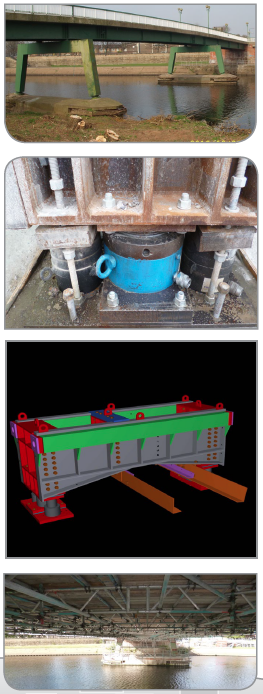 Bridge Jacking and Foot Bridge Bearing Replacement
Bridge Jacking and Foot Bridge Bearing Replacement
Client
Taylor Woodrow
Consultants
Mott MacDonald
Value
£343,000
Phase One
May 2013 – September 2013
Phase Two
December 2013 – February 2014
Originally built in 1870, Wilford Toll is an existing foot and cycle bridge over the River Trent in Nottingham City Centre. With increasing traffic and footfall, the bridge was strengthened and widened to allow for the extra traffic. The main contractor Taylor Woodrow was engaged as part of the Nottingham Express Transit 2 Scheme. Taylor Woodrow appointed Freyssinet in 2013 to undertake jacking and foot bridge bearing replacement works.
The works to Wilford Toll were carried out in two phases:
Phase One
The first phase of the works involved the replacement of the portal leg base bearings at the North and South piers, located in the centre of the River Trent. Freyssinet undertook the design, fabrication and installation of bespoke steel temporary works to facilitate the jacking of the portal legs to enable the replacement of the existing bearings.
The works were complex, and required the jacking of large steel jacking frames, hydro-demolition undertaken by Aquaforce Jetting Limited, and replacement of large bearings in excess of 1tonne per bearing with 4no bearings in total.
Location was a further complication, as the works had to be carried out in the middle of a tidal river. In order to move heavy plant and machinery out over the river onto the workplace, Freyssinet used large cranes to lift the steel temporary works out onto the piers in the middle of the river. Access to the works area was also difficult, so complex scaffolds under slung from the bridge were installed to provide access to the pier bases and crossheads.
There were also significant environmental issues that needed to be overcome. Any works that had the potential to lose or spill substances that could pollute the water had to be contained at scaffold level. Freyssinet lined the scaffolding with polythene sheeting to contain potential contaminants and bund walls were built at the base of the piers to contain any contaminants, which were then pumped to the river bank, treated with a Siltbuster unit before being discharged to ground in accordance with EA requirements.
Phase Two
The second phase of the works involved the replacement of 18no mechanical bearings at the top of the portal legs, half joints and both North and South abutments. Like at phase one, these works required hydro-demolition and bearing replacement above a tidal river.
The works were carried out on time and to budget to the satisfaction of both Taylor Woodrow and the client.
